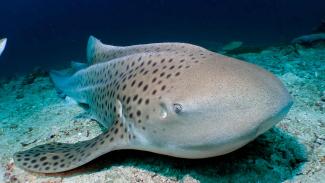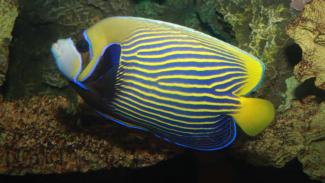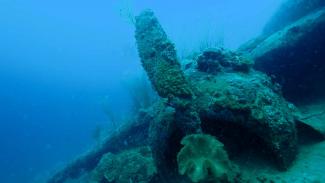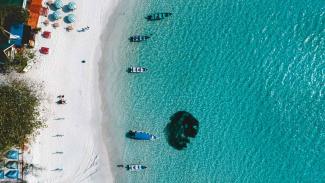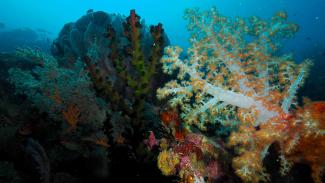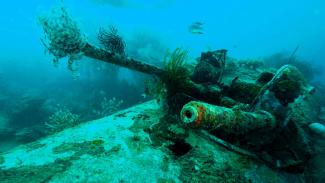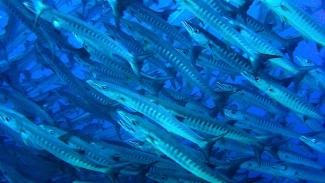
Port Moresby is the capital of Papua New Guinea and was the first diving area to be explored in the country. The city gazes out over the Coral Sea, which separates PNG from Australia in the south.
While the area is PNG’s most populous, this does not mean that the diving is of a lesser standard to other areas of the country, especially of you like rare critters.
The area's most famous resident is an elaborate Lacy Scorpionfish and many Carpet Sharks are also found including Leopard Sharks, Wobbegongs & Epaulettes.
Highlights
Best diving spots
The area's most famous resident is an elaborate Lacy Scorpionfish and many Carpet Sharks are also found including Leopard Sharks, Wobbegongs & Epaulettes. End Bommie and Suzie’s Bommie are two great dives where these critters, and more can be found. At End Bommie, the walls are covered with beautiful, large seafans that hide many of the site’s smaller residents.
Currents can be quite strong here, which bring plenty of food and therefore plenty of larger life. The species this site is most famous for however is the Lacy Scorpionfish. This master of camouflage is prevalent on this reef and comes with a wonderfully elaborate and colourful costume. Leopard Sharks have been known here too.
Suzie’s Bommie is another beautiful site, with pristine corals and a hugely diverse marine eco-system. Sitting off from the main reef, this large pinnacle rises from around 30m to 10m. In the deeper areas, look in the seafans for Pygmy Seahorses. A number of large Napoleon Wrasse are resident in the area and large schools of Fusiliers speed past in the blue. Shallower areas have numerous Lionfish and large Stonefish. The corals here are truly exceptional, making this a dive to remember.
Another very popular site around Port Moresby is The Pinnacles. This site comprises 3 coral outcrops that rise to within a few metres of the surface. Coral cover here wonderfully diverse and this is another great spot to find the Pygmy Seahorse. Schools of Fairy Basslets & Anthias provide an explosion of colour, while large schools of reef-fish & pelagic species can be seen away from the reef.
The area also has some good wreck dives, the MV Pai 2 & Pacific Gas are former fishing boats that were deliberately scuttled to make dive sites. Now encrusted with corals, these easily diveable wrecks make excellent artificial reefs, with a good number & variety of species. They also hide many rare critters, including Ghost Pipefish & Pygmy Seahorses.
One of the enoyable things about this area is the wide variety of dive sites. Sandy Passage & PJ’s Passage are great drift dives, with regular sighting of Eagle Rays, Mobulas & Manta Rays. The Caves & The Tunnels offer lovely caves and swim-throughs, while Lion Island is a great muck dive. For Shark lovers, The Big Drop is a must. Beyond the drop-off, numerous species of Shark can be spotted, including Bronze Whalers, Silvertips & Hammerheads.
For big fish lovers looking to dive somewhere really special though, a liveaboard to the Eastern Fields is a trip of a lifetime. This atoll, around 170km offshore rises from over 1km to near the surface and attracts Sharks and Rays in their hundreds. This is not a site for the faint-hearted as the strong currents and large Sharks are likely to leave you checking your air gauge much more than usual. Grey Reef Sharks are common and often seen in large numbers, while Bronze Whalers & Silvertip Sharks regularly cruise the around atoll. Scalloped Hammerheads can be seen schooling here too, but occasionally have to give way to the Great Hammerhead Shark - a truly A-list predator that will really make you feel small. In case you weren’t already feeling vulnerable, Tiger Sharks have sometimes been spotted. As if all that wasn’t enough, Eagle Rays & Manta Rays often patrol the atoll, and Barracuda & Trevally school in the hundreds.
When to dive
Port Moresby area can be dived all year round, with January to March bringing wetter weather. The exposed nature of Eastern Fields means it is most definitely only for experienced divers and can only be visited between April & May or November & December.
Getting there
There is an airport in Port Moresby with connections to all the country's dive spots, as well as international flights.
Activities
The city has a museum to visit and reasonable shopping opportunities, but little else of interest to tourists.
Resort and liveaboard options
Being the country's capital, Port Moresby has plenty of accommodation options. It is not a particularly popular place to stay for tourists however and many people prefer to stay at resorts outside of the city centre. Lolotata Island is an attractive option for scuba divers.


